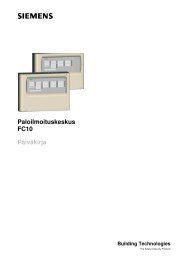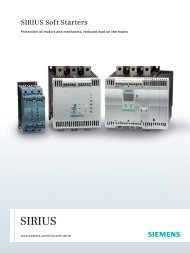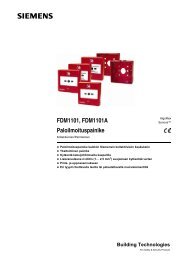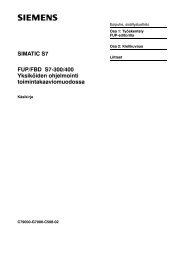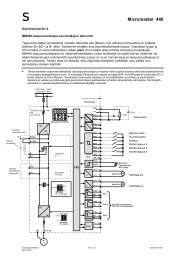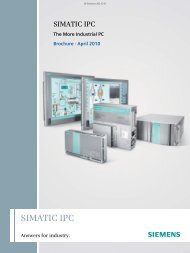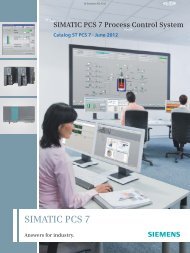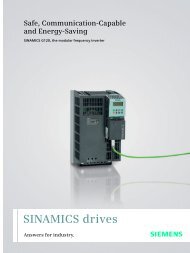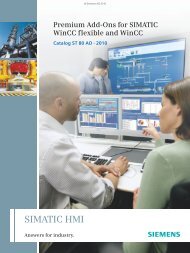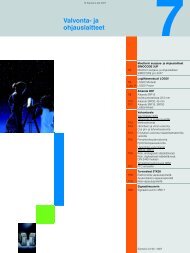Catalog LV 70 2011 - Low & Medium Voltage - Siemens
Catalog LV 70 2011 - Low & Medium Voltage - Siemens
Catalog LV 70 2011 - Low & Medium Voltage - Siemens
You also want an ePaper? Increase the reach of your titles
YUMPU automatically turns print PDFs into web optimized ePapers that Google loves.
Appendix<br />
© <strong>Siemens</strong> AG <strong>2011</strong><br />
6<br />
Glossary<br />
■ Overview<br />
This glossary offers brief explanations of some of the terms used<br />
in this catalog. However it must not be regarded as a substitute<br />
for the actual text of the standard, especially where the new<br />
terms used in IEC/EN 60947 are concerned.<br />
Altitude<br />
Ambient temperature, enclosed<br />
(see also IEV 441-11-13)<br />
Ambient temperature, open<br />
(see also IEV 441-11-13)<br />
Back-of-hand proof<br />
(see also EN 50274; 3.9)<br />
Clearance in air<br />
(see also IEC/EN 60947-1; 2.5.46/IEV 441-17-31)<br />
Control circuit reliability<br />
Creepage distance<br />
(see also IEC/EN 60947-1; 2.5.51/IEV 151-03-37)<br />
Damp heat, constant<br />
Damp heat, cyclical<br />
Degree of pollution<br />
(see also IEC/EN 60947-1; 5.5.58)<br />
EMERGENCY-STOP switching device<br />
Finger-safe<br />
(see also EN 50274; 3.8)<br />
Reference is made underneath each term to the relevant section<br />
in the standard, e.g. IEC/EN 60947-1. Additionally, IEV numbers<br />
are stated in order to enable you to find foreign language equivalents<br />
in the electrotechnical dictionary (IEC 50: International<br />
Electrotechnical Vocabulary), e.g. IEV 441-17-31.<br />
The density of air decreases with increasing altitude, and this reduces<br />
its insulating capacity as well as its heat transfer capability. The rated<br />
operational voltage and rated operational current of switching<br />
devices, conductors and motors as well as the tripping behavior of<br />
thermal overload relays are affected by this.<br />
Upon request, <strong>Siemens</strong> will supply information as to the suitability or<br />
otherwise of switchgear for operation at altitudes above the 2000 m<br />
limit specified by the standard. Or get in direct touch with Technical<br />
Support (see page 6/17).<br />
Temperature at which the switching device is capable of being operated<br />
within a closed enclosure. For this purpose, it must be taken into<br />
account that the power losses of the device will add to the internal<br />
temperature rise within the enclosure.<br />
Room temperature (e.g. of the workshop or contact chamber) in which<br />
the switching device is located.<br />
An equipment whose live parts cannot be touched by a sphere of<br />
50 mm diameter is regarded as back-of-hand proof.<br />
The spacing between two conductive parts along a string stretched the<br />
shortest way between these conductive parts. The clearance in air is<br />
determined by the rated impulse withstand voltage, overvoltage category<br />
and the pollution degree.<br />
Measures the probability of switching states arising during the endurance<br />
of a switching contact that would be interpreted as faults by<br />
downstream electronic controllers (PLCs). Control circuit reliability is<br />
expressed in values based on tests using standard limit values for signals<br />
according to IEC/EN 61131-2.<br />
The shortest distance along the surface of the insulating material<br />
between two conductive parts. The creepage path/distance is determined<br />
by the rated insulation voltage, the pollution degree and the<br />
creepage current resistance of the material used.<br />
This test subjects the equipment to an ambient temperature of 40 °C at<br />
a constant humidity of 93 %. At set intervals during the test, the electrical<br />
and mechanical function of the equipment are examined.<br />
This test subjects the equipment to cyclically changing climatic conditions.<br />
A cycle applies 40 °C ambient temperature at 93 % relative<br />
humidity for 12 hours, followed by 12 hours of 25 °C at 95 %. At set<br />
intervals during the test, the electrical and mechanical function of the<br />
equipment are examined.<br />
Ident. No. for the prospective quantities of conductive dust and humidity,<br />
which can lead to a reduction in the control circuit reliability of a<br />
switching device. The degree of pollution is defined by the following<br />
factors:<br />
• Degree of pollution 1:<br />
No pollution or only dry, non-conductive pollution occurs. The pollution<br />
has no effect on the control circuit reliability.<br />
• Degree of pollution 2:<br />
Usually, only non-conductive pollution. However, transient conductivity<br />
through condensation is to be expected.<br />
• Degree of pollution 3: (switchgear for industrial use) Conductive pollution<br />
or dry, non-conductive pollution, which is rendered conductive<br />
through condensation.<br />
• Degree of pollution 4:<br />
The pollution leads to long-term conductivity, e.g. pollution through<br />
conductive dust, rain or snow.<br />
Switching device with an EMERGENCY-STOP device that is intended to<br />
prevent danger to persons, damage to machinery or work materials.<br />
An equipment whose live parts cannot be touched by the operator during<br />
actuation is termed finger-safe. This also affects operator activity on<br />
neighboring switching devices. The finger-safe area of a push-actuated<br />
operating medium is a circular area of at least 30 mm radius around the<br />
actuator, and vertical to the direction of actuation. Within this circular<br />
area, touch-critical parts must be located at not less than 80 mm below<br />
the actuating level.<br />
6/2 <strong>Siemens</strong> <strong>LV</strong> <strong>70</strong> · 04/<strong>2011</strong>





